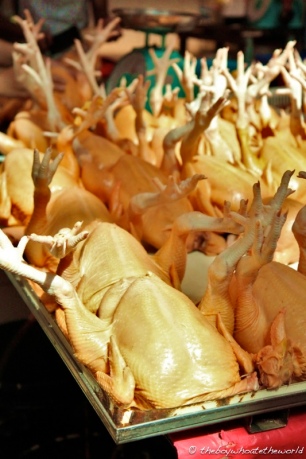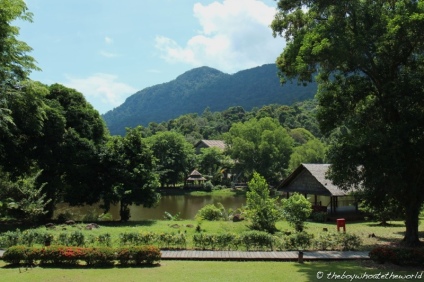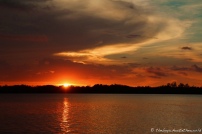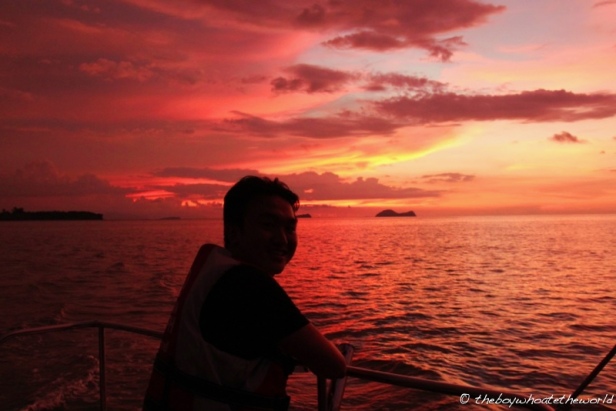Spectacular Sarawak: The Kuching Chronicles
Despite growing up in Malaysia’s capital of KL, I never quite got round in my younger days to discovering what Sarawak and the rest of East Malaysia had to offer before moving over to the UK. I’ll be honest, from a KL boy’s perspective, East Malaysia can sometimes seem like a completely different realm out there in Borneo.
Hence, when the folks over at Malaysia Airlines UK invited me to join a blogger’s trip they were organising to show off the very best of Sarawak, I jumped at the opportunity in a heartbeat to discover this lesser known side of my motherland. To top it off, our host for the trip was TV chef and Youtube star Caroline Mili Artiss, whose maternal family are natives of Sarawak’s capital, Kuching. And where there’s family involved in Malaysia, you know there’s bound to be some fabulous food and good times.
As soon as you step off the plane in Kuching, one thing soon becomes overwhelmingly clear – the sheer amount of space here in Sarawak is vast. The largest of Malaysia’s 13 states, Sarawak covers just under 125,000 square kilometers. That’s over half the size of the UK! A drive through Kuching’s town will see you pass through some of the widest roads and largest roundabouts in Malaysia. But it’s out in the rural areas where the vastness of Sarawak really comes into its own. There’s lush, vibrant greenery and wildlife further than the eye can see in every direction you look. As we ventured further out from Kuching towards Santubong National Park and the coast, the backdrop soon gave way to towering mountains heaving with emerald flora and expansive rivers that weaved through the landscape. Unspoiled rainforests and mangroves are home to orangutans, proboscis monkeys and fireflies. In the rivers, Irrawady dolphins share their habitat with killer crocodiles. And lets not forget Sarawak’s spectacular sunsets – lighting up the skies every evening in an ever-changing, fiery blaze of glory.
This natural abundance and biodiversity has left an indelible mark on the region’s food culture. Sarawakian cuisine is simpler, fresher and lighter on the palate than the food you find in Peninsula Malaysia. Local ingredients like jungle fern (midin), wild ginger and torch ginger buds (bunga kantan) are used liberally and celebrated in Sarawakian specialities. Hollowed bamboo stalks are used as natural, disposable cookware. Bamboo and banana leaves are often used as wrappers and cartouches in the cooking process. All this makes for a unique, produce-driven cuisine that’s completely in tune with their natural surroundings.
But for me, the biggest draw of Sarawak are the local people themselves. The local folk I had the pleasure of meeting over the course of our trip were genuinely some of the most friendly, helpful and easy going bunch you will find anywhere in South East Asia. Caroline’s aunts, uncles and cousins welcomed us like family from the very first hello. Vegetable sellers, fishmongers and butchers in the local markets were open and engaging – trading jokes and offering plenty of insight into their exotic produce. Street food vendors, however busy they were, managed to find a minute or two in the organized chaos to share their stories and heritage. With a population of over 300,000, Kuching isn’t exactly the smallest of towns. Somehow though, it still manages to exude that sense of community where everybody pitches in to help one another out. Underneath the modest and relaxed demeanor of the locals here, I sense an immense pride in the culture, cuisine and heritage of their hometown and state. And rightly so – this wonderful region is truly one of the crowning gems of this country I’m proud to call home.
Here’s a round up of the very best sights, stays and eats from a truly memorable adventure in and around Kuching.
Things to do in Sarawak
Located approximately 25km south-west from central Kuching, Semenggoh Wildlife Reserve, is home to 27 orangutans. Established in 1975, 11 of the sanctuary’s orangutans were rescued from captivity and rehabilitated whilst 16 were born here. Feeding takes place daily from 9am – 10am and again in the afternoon from 3pm – 330pm. There’s no guarantee though that the orangutans will show up to the feeding areas on any given day. During fruiting season, we were told the orangutans can often go for days on their own in the wild before returning to the park rangers for a free meal. Hence, we were extremely lucky to able to meet 7 members of the family on our visit, including Richie, the dominant alpha-male as well as Seduku, the grandmother and oldest of the lot. It never ceases to amaze me how human they are up close. Read more about the rehabilitation work that the sanctuary does here.
Semenggoh Wildlife Reserve
A visit to Satok Weekend Market (Medan Niaga Satok) is a must to witness the freshness and abundance of Sarawakian produce in its full glory. Bountiful crates of bunga kantan (torch ginger bud) sit side by side with bouquets of midin (jungle fern). There’s fresh seafood galore alongside butchers offering entire carcasses from nose to tail. World-renowned Sarawak peppercorns are sold by the kilogram here as are exotics like cow’s heads and live sago worms! I’m told the latter are libido-boosting delicacies that locals often wash down with a pint of Guinness. If you don’t fancy sago worms, there’s also a food court in the market complex where you can tuck into local delicacies like Sarawak Laksa and Kolo Mee.
Satok Weekend Market
Explore the heritage of Sarawak’s native Dayak people at the Sarawak Cultural Village. Visit the traditional long-houses of the Iban (water), Bidayuh (land), Ulu (hill) and Melanau (coastal) tribes and witness the idiosyncrasies of tribal culture first hand through their food, music, dance and superstitions. Examine real human skulls leftover from the days of tribal headhunting or have a go at shooting darts with a blowpipe! There’s also authentic local Sarawakian food and cookery demos available at the village.
Sarawak Cultural Village
Channel your inner David Attenborough and search for Irrawaddy dolphins, deadly crocodiles and rare proboscis monkeys on a Santubong Wildlife Cruise up the Salak and Santubong rivers. As the light fades and evening approaches, revel in the ridiculously beautiful sunsets which light up the skies in these parts.
Santubong Wildlife Cruise
Where to eat in Sarawak
For a taste of the local street food scene, head over to Lau Ya Keng on Carpenter Street, located opposite the Chinese temple. A former outdoor theatre used by the Teow Chew society for performances, it’s a large, buzzing space that showcases a whole host of Sarawak’s most iconic specialities – chief among them Sarawak Laksa and Pork Satay. Laksa here comes fully loaded with fresh shrimp, clams, scallops, fish balls and chicken. The reddish-bown Laksa broth – a delectable potion of sambal (chilli paste), local Sarawak pepper and other Malaysian spices is lighter and less fussy compared to the full-on Assam and Curry Laksas you get in Penang and Malacca. The Pork Satay here is seriously to die for. Smoky, tender and chargrilled to absolute perfection, it’s a cross between a juicy piece of char siu (BBQ Roast Pork) and Ba Kwa (BBQ Chinese Jerky) on a skewer. That sweet, savoury and sticky marinade of dark soy, honey, Sarawak pepper and 5 spice has got to be one of the most moreish marinades in Malaysian cuisine. A sure contender for one of the best satays in the country if you ask me!
Lau Ya Keng
A popular breakfast haunt with the local Kuching folk, Four Happiness Café specializes in Foo Chow cuisine, a subregion in the Southern Chinese province of Fujian. Uncle Tong, the resident chef here has been dishing out his famous red wine chicken mee sua (‘long life noodles’) & dry-style beef noodles for over 15 years. There’s also freshly pulled teh tarik (sweet milk tea) & kaya (coconut jam) toast, chargrilled the old-school way over hot coals. Make sure you get there early – I hear Uncle Tong usually sells out by late morning!
Four Happiness Cafe (a.k.a. Uncle Tong’s)
If you happen to be out and about in the Santubong area on a river cruise or at the cultural village, a seafood dinner at nearby Lim Hock Ann Seafood Restaurant in Kampung Buntal is an absolute must. Located in a local fishing village, there’s seafood galore, all prepared simply and lovingly to let the freshness of the day’s catch do the talking. Local bamboo clams and white pomfret, steamed with ginger, garlic and little else was a reminder that you don’t need big, gutsy flavours for Malaysian cuisine to shine. Jumbo ‘kepah’ clams (some the size of a cricket balls!) cooked in a fragrant lemongrass and tamarind broth were a real highlight as was their signature dish of Mud Crabs, fried in salted egg, butter and curry leaves.
Lim Hock Ann Seafood Restaurant, Kampung Buntal
For a more interactive culinary experience where you can learn all about the local cuisine and help prepare your own Sarawakian feast, Telang Usan Hotel in central Kuching offer hands-on cookery classes with dinner. Chef Inyau, a 25 year kitchen veteran taught us the secrets behind local specialities such as Umai (a ceviche-like dish of cured snapper), Midin Kerabu (pickled jungle fern salad) and Ayam Pansoh (Bamboo chicken). For dinner, tuck into the dishes you helped to cook up along with some of Chef Inyau’s other signatures like his Sarawak Laksa and Rojak.
Places to stay in Sarawak
There are accommodation options aplenty in and around Kuching. So whether it’s a seaside resort, a cosy village homestay or 5-star luxury in the city, here are a few ideas of places to stay in Sarawak.
For some beachside R&R, there’s the Damai Beach Resort, located an hour’s drive from central Kuching at the foothills of Mount Santubong. The décor of the rooms are a bit dated, but prepare yourself for some seriously serene surroundings and stunning sunsets. There’s also easy access to the nearby Sarawak cultural village and wildlife cruises along the Santubong and Salak rivers. For a more boutique hideaway that brings together the best of old and new, have a look at The Village House, an upmarket homestay in Santubong. There’s a range of room options available from shared hostel-style accommodation for the independent traveler to more spacious suites for those looking to treat themselves. If you are after 5-star luxury with all the mod-cons, the Pullman Kuching located smack in the middle of town offers panaromic views across the city and the silkiest and softest of bedsheets out there to get a good night’s rest.
How to get there
For those travelling from the UK, Malaysia Airlines (MAS) offer a direct, twice daily A380 service between London Heathrow to Kuala Lumpur International Airport (KLIA). From KLIA, there are a range of onward connections to Kuching as well as other domestic and international destinations across Malaysia, the Far East and Australasia. Economy class return tickets from London to Kuching (via Kuala Lumpur) start from ~£800 all-in. Business Class fares from ~£3000 all-in.
First and Business Class passengers on Malaysia Airlines will get to sample local favourites like Sambal Prawns with Nasi Lemak and gourmet specialities like Braised Lamb Shank onboard using the airline’s Chef-on-call meal pre-selection service. There’s also their signature satay trolley service to look forward to – every stick marinated and hand-skewered from scratch then char-grilled over specially selected mangrove coals to perfection. Of all the plane food I’ve had the pleasure (and pain) of tasting over the years, MAS’ satay remains the tastiest thing at 30,000 feet out there!
So it’s goodbye for now Sarawak, you land of amazing wildlife, stunning sunsets and delicious, delicious food. I will most certainly be back again soon…
G.





































































wonderful post! ❤ please visit my blog ❤ https://enjoybypaula.wordpress.com/
@Paula: Cheers Paula, thanks for stopping by!
Pingback: theboywhoatetheworld cooks: Sarawak Laksa | the boy who ate the world
Pingback: My 15 Eats of 2015 | the boy who ate the world
i have only just come across your article and enjoyed it immensely, i was stationed in Kuching in 1965-1966, (i was also in Labuan and short visit to Sibu but spent most of my time in Kuching) your article has brought back very fond memories of Sarawak. my only regret is i never returned there and unfortunately because of ill health i never will BUT i have my memories…………….i hope you will see this comment as i know this piece is 2 years old.
@Pete: Glad it’s brought back good memories of Sarawak for you! I’m headed back to Kuching with the family again this July – can’t wait. All the best!
all the very best to you and your family, i wish you well.